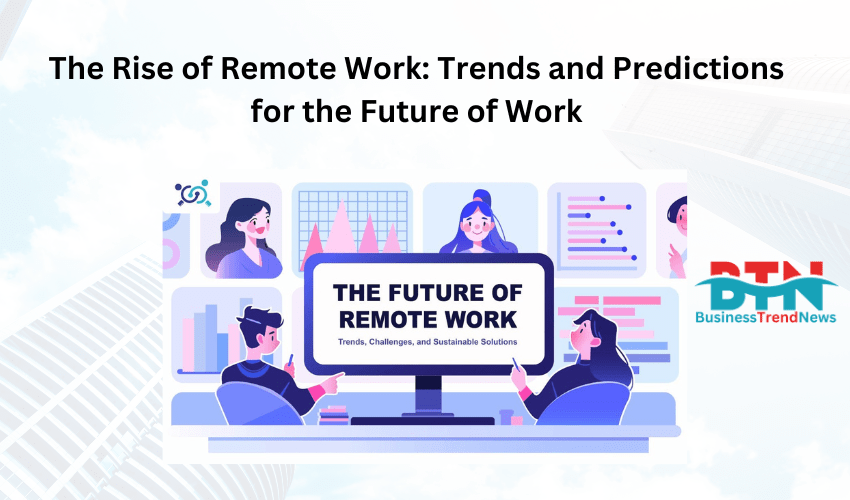![]()
The Rise of Remote Work: Trends and Predictions for the Future of Work
The COVID-19 pandemic accelerated the global shift to remote work, transforming how companies operate and how employees interact with their employers. What was once considered a perk or an occasional arrangement is now a mainstream business model, with many companies adopting remote or hybrid work arrangements permanently. The rapid rise of remote work has changed the corporate landscape, providing both opportunities and challenges for businesses and workers alike.
This article will explore the trends that have shaped remote work, the predictions for its future, and how businesses can adapt to this new reality. Whether you are a business owner or an employee, understanding the dynamics of remote work is crucial in today’s fast-evolving workplace.
Table of Contents:
- Introduction to Remote Work
- Historical Evolution of Remote Work
- Factors Driving the Rise of Remote Work
- Remote Work Trends Post-COVID-19
- The Benefits of Remote Work for Businesses
- Challenges of Remote Work for Companies and Employees
- Key Tools and Technologies for Remote Work
- Hybrid Work Models: A New Normal?
- Remote Work Predictions for the Future
- The Impact of Remote Work on Company Culture
- How to Build a Successful Remote Work Strategy
- Conclusion
1. Introduction to Remote Work
Remote work, also known as telecommuting, refers to a work arrangement where employees perform their job duties from a location outside of the traditional office, often from home or another remote location. While remote work existed before the COVID-19 pandemic, it became a global phenomenon in 2020 as companies quickly adapted to government-mandated lockdowns and social distancing measures.
Remote work offers employees flexibility and the ability to maintain a better work-life balance, while companies benefit from reduced overhead costs and access to a broader talent pool. However, this transition has raised questions about productivity, employee engagement, and long-term sustainability, leading to a surge in discussions about the future of work.
2. Historical Evolution of Remote Work
Remote work is not a new concept. It has been around for decades, with the earliest forms appearing as telecommuting in the 1970s. Back then, employees would use telephones and fax machines to communicate and send documents, but this form of remote work was limited to specific sectors, such as customer service and sales.
The rise of the internet in the 1990s paved the way for more widespread remote work, as email and cloud-based services allowed employees to collaborate from a distance. However, it wasn’t until the 2000s, with the advent of high-speed internet, video conferencing, and collaboration tools, that remote work became a viable option for a wide range of industries.
3. Factors Driving the Rise of Remote Work
Several factors have contributed to the rapid rise of remote work in recent years, some of which were accelerated by the global pandemic. These factors include:
- Technological Advancements: Advances in cloud computing, collaboration software, and communication tools like Slack, Zoom, and Microsoft Teams have made it easier for employees to work from anywhere.
- Cost Savings: Both employees and employers benefit from the cost savings associated with remote work. Workers save money on commuting and office attire, while companies can reduce expenses on office space and utilities.
- Work-Life Balance: Remote work allows employees to better manage their personal and professional responsibilities. Flexibility in working hours can lead to higher job satisfaction and productivity.
- Global Talent Pool: Companies are no longer constrained by geography when hiring talent. Remote work allows businesses to recruit the best professionals from anywhere in the world, making the workplace more diverse and inclusive.
4. Remote Work Trends Post-COVID-19
The global pandemic created an unprecedented need for remote work, forcing companies to adopt new workflows and technologies quickly. Post-pandemic, some trends have solidified, indicating that remote work is here to stay:
Major Remote Work Trends:
- Permanent Remote and Hybrid Models: Many companies, including major tech firms like Facebook, Twitter, and Shopify, have announced permanent or hybrid remote work options, allowing employees to work remotely full-time or a few days a week.
- Increased Use of Digital Collaboration Tools: Tools like Slack, Zoom, Trello, and Asana have become essential for teams to collaborate remotely. Their usage continues to grow as remote work becomes more mainstream.
- Growth in Remote Job Listings: Job platforms have seen a surge in remote work opportunities. According to LinkedIn, remote job listings have increased by over 600% since the beginning of the pandemic.
- Expansion of Gig and Freelance Economy: Remote work has contributed to the growth of the gig economy, with more individuals taking on freelance work or short-term contracts to supplement their income or work independently.
5. The Benefits of Remote Work for Businesses
Remote work offers numerous advantages to businesses, making it a desirable option for many employers. Some of the most notable benefits include:
- Cost Savings: Businesses save on office rent, utilities, and equipment. A reduction in on-site employees means fewer resources are needed to maintain the office.
- Increased Productivity: Studies have shown that remote workers are often more productive than their office-based counterparts. Without the distractions of office chatter and long commutes, employees can focus better on their tasks.
- Employee Retention and Attraction: Offering remote work options can help attract top talent and improve employee retention. Workers value flexibility, and companies that offer remote options have a competitive advantage in recruiting.
- Environmental Impact: Reduced commuting leads to lower carbon emissions, making remote work a more sustainable option. Companies can also reduce their environmental footprint by downsizing or eliminating physical office spaces.
6. Challenges of Remote Work for Companies and Employees
While remote work has many advantages, it also presents challenges for both businesses and employees. These challenges include:
For Businesses:
- Maintaining Productivity: Not all employees thrive in a remote environment. It can be difficult for some workers to stay motivated and productive without the structure of an office setting.
- Data Security: With employees working from various locations, ensuring data security becomes a more significant concern. Businesses must invest in secure communication and collaboration tools to protect sensitive information.
- Managing Teams Remotely: Remote work requires different management strategies. Supervisors need to focus on outcomes rather than hours worked and find ways to keep teams engaged and aligned with company goals.
For Employees:
- Isolation and Mental Health: Remote workers may feel isolated or disconnected from their colleagues, leading to potential mental health challenges. The absence of social interactions can result in feelings of loneliness and stress.
- Work-Life Balance: While remote work can improve work-life balance, it can also blur the boundaries between personal and professional life. Employees may struggle to “switch off” from work when their home becomes their office.
7. Key Tools and Technologies for Remote Work
The success of remote work hinges on the use of various digital tools and platforms that facilitate communication, collaboration, and project management. Here are some of the key technologies that have enabled the rise of remote work:
- Communication Tools: Platforms like Slack, Microsoft Teams, and Zoom provide real-time communication through messaging, voice calls, and video conferencing.
- Collaboration Tools: Applications like Trello, Asana, and Monday.com help teams manage projects, assign tasks, and track progress in a transparent and organized manner.
- Cloud Storage and File Sharing: Cloud-based platforms such as Google Drive, Dropbox, and OneDrive enable remote teams to store, access, and share documents and files securely.
- Time Management Tools: Tools like Toggl, RescueTime, and Clockify help employees manage their time, monitor productivity, and ensure that tasks are completed efficiently.
8. Hybrid Work Models: A New Normal?
The hybrid work model, which combines remote work and in-office work, is becoming increasingly popular among businesses that want the flexibility of remote work but also value in-person collaboration. In a hybrid model, employees can choose to work from the office on certain days and remotely on others.
Key Benefits of the Hybrid Model:
- Flexibility: Employees have the flexibility to work where they are most productive, whether at home or in the office.
- Improved Collaboration: Hybrid work allows for in-person meetings and team-building activities while still accommodating remote work schedules.
- Reduced Office Space: Companies can downsize their office spaces since fewer employees will be on-site at any given time, leading to cost savings.
9. Remote Work Predictions for the Future
Remote work is no longer a temporary solution—it is here to stay. As businesses and employees adjust to this new way of working, several key predictions emerge for the future of remote work:
- Increase in Remote Job Opportunities: More businesses will continue to offer remote work options, making it easier for job seekers to find positions that allow them to work from anywhere.
- Advanced Collaboration Technologies: New technologies, including AI-powered virtual assistants, immersive virtual reality (VR) meeting spaces, and enhanced remote work platforms, will further facilitate remote work and collaboration.
- Focus on Employee Well-Being: As remote work becomes more widespread, companies will prioritize mental health and well-being programs to address the challenges of isolation and work-life balance.
- Expansion of Global Teams: With remote work, businesses will have the freedom to build more diverse and global teams, tapping into talent from across the world.
10. The Impact of Remote Work on Company Culture
One of the concerns surrounding remote work is its potential impact on company culture. A strong corporate culture is often built through face-to-face interactions, team-building exercises, and casual conversations in the office. With remote work, companies must find new ways to foster a sense of community and belonging.
Strategies to Maintain Culture in a Remote Setting:
- Regular Check-ins: Virtual meetings, one-on-one check-ins, and team-wide video conferences help maintain communication and connection.
- Virtual Team Building: Companies can organize virtual happy hours, team-building activities, and online workshops to keep employees engaged and connected.
- Transparent Communication: Establishing clear communication channels and fostering a culture of openness and transparency can help remote employees feel included and informed.
11. How to Build a Successful Remote Work Strategy
For businesses to succeed in a remote work environment, they need a well-thought-out strategy that includes policies, tools, and management practices. Here are some key steps to building a successful remote work strategy:
- Set Clear Expectations: Define the goals and objectives for remote work, including communication protocols, performance metrics, and work hours.
- Invest in the Right Tools: Ensure that employees have access to the necessary technology, including communication platforms, project management tools, and security software.
- Support Employee Well-Being: Offer resources and support for employees’ mental and physical health, including flexible work hours, wellness programs, and mental health services.
- Foster Collaboration and Communication: Encourage regular communication between teams and provide opportunities for collaboration through virtual meetings and shared workspaces.
12. Conclusion
The rise of remote work is reshaping the modern workplace, offering both opportunities and challenges for businesses and employees. As companies continue to adapt to this new reality, it is clear that remote work is not just a trend—it is the future of work. By embracing the benefits of remote work while addressing its challenges, businesses can create more flexible, efficient, and resilient work environments.
As we move forward, remote work will likely evolve, driven by advances in technology, changing employee expectations, and the ongoing shift in how businesses operate. Whether you are an employee seeking flexibility or a business leader looking to adapt, understanding the trends and predictions for remote work will be essential for success in the years to come.



